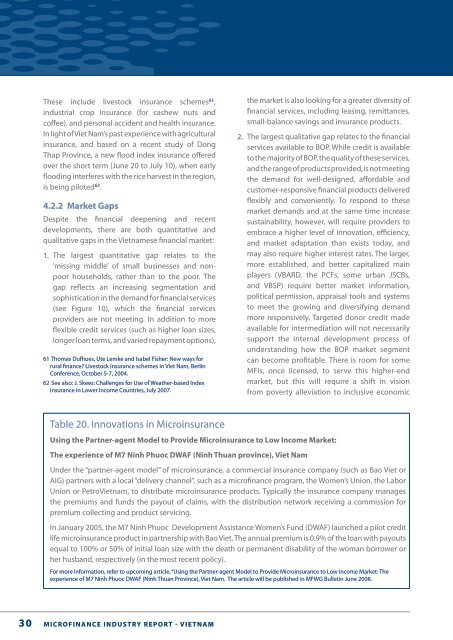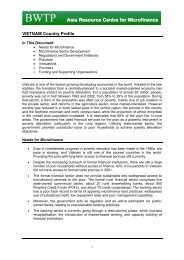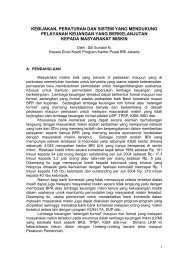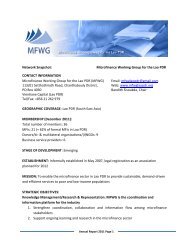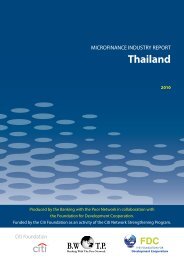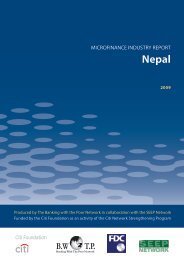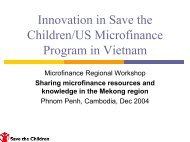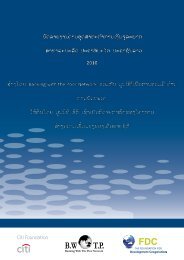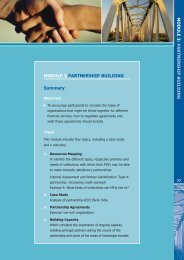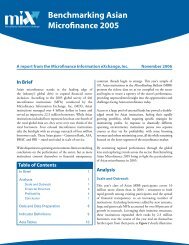microfinance industry report - Vietnam - Banking with the Poor Network
microfinance industry report - Vietnam - Banking with the Poor Network
microfinance industry report - Vietnam - Banking with the Poor Network
You also want an ePaper? Increase the reach of your titles
YUMPU automatically turns print PDFs into web optimized ePapers that Google loves.
These include livestock insurance schemes 61 ,<br />
industrial crop insurance (for cashew nuts and<br />
coffee), and personal accident and health insurance.<br />
In light of Viet Nam’s past experience <strong>with</strong> agricultural<br />
insurance, and based on a recent study of Dong<br />
Thap Province, a new flood index insurance offered<br />
over <strong>the</strong> short term (June 20 to July 10), when early<br />
flooding interferes <strong>with</strong> <strong>the</strong> rice harvest in <strong>the</strong> region,<br />
is being piloted 62 .<br />
4.2.2 Market Gaps<br />
Despite <strong>the</strong> financial deepening and recent<br />
developments, <strong>the</strong>re are both quantitative and<br />
qualitative gaps in <strong>the</strong> <strong>Vietnam</strong>ese financial market:<br />
1. The largest quantitative gap relates to <strong>the</strong><br />
‘missing middle’ of small businesses and nonpoor<br />
households, ra<strong>the</strong>r than to <strong>the</strong> poor. The<br />
gap reflects an increasing segmentation and<br />
sophistication in <strong>the</strong> demand for financial services<br />
(see Figure 10), which <strong>the</strong> financial services<br />
providers are not meeting. In addition to more<br />
flexible credit services (such as higher loan sizes,<br />
longer loan terms, and varied repayment options),<br />
61 Thomas Dufhues, Ute Lemke and Isabel Fisher: New ways for<br />
rural finance? Livestock insurance schemes in Viet Nam, Berlin<br />
Conference, October 5-7, 2004.<br />
62 See also: J. Skees: Challenges for Use of Wea<strong>the</strong>r-based Index<br />
Insurance in Lower Income Countries, July 2007.<br />
<strong>the</strong> market is also looking for a greater diversity of<br />
financial services, including leasing, remittances,<br />
small-balance savings and insurance products.<br />
2. The largest qualitative gap relates to <strong>the</strong> financial<br />
services available to BOP. While credit is available<br />
to <strong>the</strong> majority of BOP, <strong>the</strong> quality of <strong>the</strong>se services,<br />
and <strong>the</strong> range of products provided, is not meeting<br />
<strong>the</strong> demand for well-designed, affordable and<br />
customer-responsive financial products delivered<br />
flexibly and conveniently. To respond to <strong>the</strong>se<br />
market demands and at <strong>the</strong> same time increase<br />
sustainability, however, will require providers to<br />
embrace a higher level of innovation, efficiency,<br />
and market adaptation than exists today, and<br />
may also require higher interest rates. The larger,<br />
more established, and better capitalized main<br />
players (VBARD, <strong>the</strong> PCFs, some urban JSCBs,<br />
and VBSP) require better market information,<br />
political permission, appraisal tools and systems<br />
to meet <strong>the</strong> growing and diversifying demand<br />
more responsively. Targeted donor credit made<br />
available for intermediation will not necessarily<br />
support <strong>the</strong> internal development process of<br />
understanding how <strong>the</strong> BOP market segment<br />
can become profitable. There is room for some<br />
MFIs, once licensed, to serve this higher-end<br />
market, but this will require a shift in vision<br />
from poverty alleviation to inclusive economic<br />
Table 20. Innovations in Microinsurance<br />
Using <strong>the</strong> Partner-agent Model to Provide Microinsurance to Low Income Market:<br />
The experience of M7 Ninh Phuoc DWAF (Ninh Thuan province), Viet Nam<br />
Under <strong>the</strong> “partner-agent model” of microinsurance, a commercial insurance company (such as Bao Viet or<br />
AIG) partners <strong>with</strong> a local “delivery channel”, such as a <strong>microfinance</strong> program, <strong>the</strong> Women’s Union, <strong>the</strong> Labor<br />
Union or Petro<strong>Vietnam</strong>, to distribute microinsurance products. Typically <strong>the</strong> insurance company manages<br />
<strong>the</strong> premiums and funds <strong>the</strong> payout of claims, <strong>with</strong> <strong>the</strong> distribution network receiving a commission for<br />
premium collecting and product servicing.<br />
In January 2005, <strong>the</strong> M7 Ninh Phuoc Development Assistance Women’s Fund (DWAF) launched a pilot credit<br />
life microinsurance product in partnership <strong>with</strong> Bao Viet. The annual premium is 0.9% of <strong>the</strong> loan <strong>with</strong> payouts<br />
equal to 100% or 50% of initial loan size <strong>with</strong> <strong>the</strong> death or permanent disability of <strong>the</strong> woman borrower or<br />
her husband, respectively (in <strong>the</strong> most recent policy).<br />
For more information, refer to upcoming article, “Using <strong>the</strong> Partner-agent Model to Provide Microinsurance to Low Income Market: The<br />
experience of M7 Ninh Phuoc DWAF (Ninh Thuan Province), Viet Nam. The article will be published in MFWG Bulletin June 2008.<br />
30 <strong>microfinance</strong> <strong>industry</strong> <strong>report</strong> - vietnam<br />
<strong>Vietnam</strong>e_Report_FOR_PRINT.indd 30<br />
27/05/2009 7:46:03 PM


